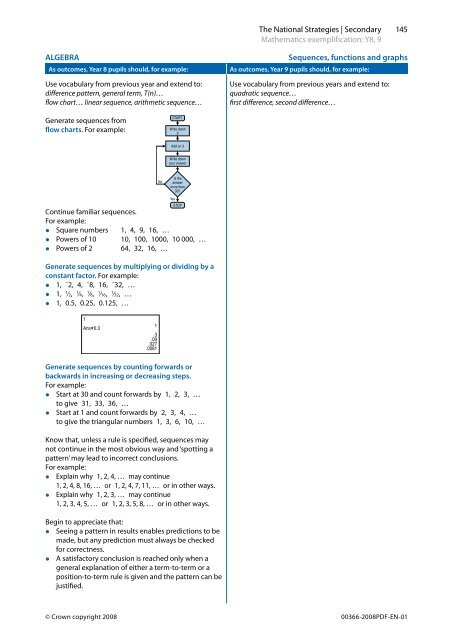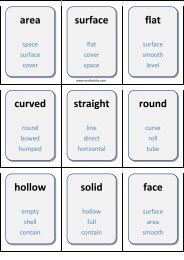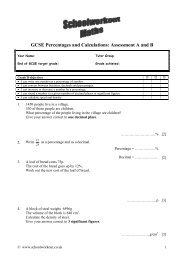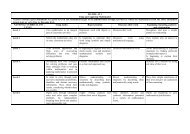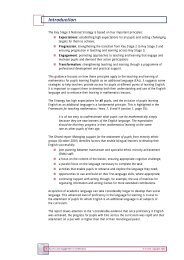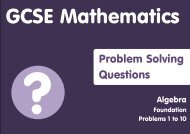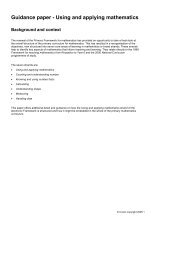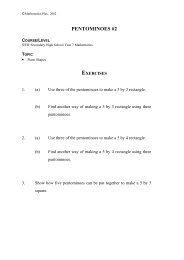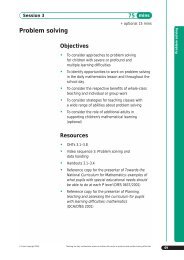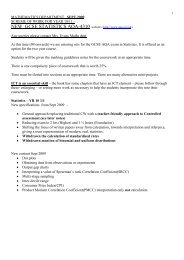ALGEBRA Equations, formulae, expressions and ... - Suffolk Maths
ALGEBRA Equations, formulae, expressions and ... - Suffolk Maths
ALGEBRA Equations, formulae, expressions and ... - Suffolk Maths
You also want an ePaper? Increase the reach of your titles
YUMPU automatically turns print PDFs into web optimized ePapers that Google loves.
The National Strategies | Secondary<br />
Mathematics exemplification: Y8, 9<br />
145<br />
<strong>ALGEBRA</strong><br />
As outcomes, Year 8 pupils should, for example:<br />
Use vocabulary from previous year <strong>and</strong> extend to:<br />
difference pattern, general term, T(n)…<br />
flow chart… linear sequence, arithmetic sequence…<br />
Sequences, functions <strong>and</strong> graphs<br />
As outcomes, Year 9 pupils should, for example:<br />
Use vocabulary from previous years <strong>and</strong> extend to:<br />
quadratic sequence…<br />
first difference, second difference…<br />
Generate sequences from<br />
flow charts. For example:<br />
START<br />
Write down<br />
2<br />
Add on 3<br />
Write down<br />
your answer<br />
Continue familiar sequences.<br />
For example:<br />
Square numbers 1, 4, 9, 16, …<br />
Powers of 10 10, 100, 1000, 10 000, …<br />
• Powers of 2 64, 32, 16, …<br />
Generate sequences by multiplying or dividing by a<br />
constant factor. For example:<br />
1, – 2, 4, – 8, 16, – 32, …<br />
1, 1 ⁄2, 1 ⁄4, 1 ⁄8, 1 ⁄16, 1 ⁄32, …<br />
• 1, 0.5, 0.25, 0.125, …<br />
1<br />
Ans<br />
* 0.3 1<br />
.3<br />
.09<br />
.027<br />
.0081<br />
Generate sequences by counting forwards or<br />
backwards in increasing or decreasing steps.<br />
For example:<br />
• Start at 30 <strong>and</strong> count forwards by 1, 2, 3, …<br />
to give 31, 33, 36, …<br />
•<br />
Start at 1 <strong>and</strong> count forwards by 2, 3, 4, …<br />
to give the triangular numbers 1, 3, 6, 10, …<br />
Know that, unless a rule is specified, sequences may<br />
not continue in the most obvious way <strong>and</strong> ‘spotting a<br />
pattern’ may lead to incorrect conclusions.<br />
For example:<br />
• Explain why 1, 2, 4, … may continue<br />
1, 2, 4, 8, 16, … or 1, 2, 4, 7, 11, … or in other ways.<br />
•<br />
Explain why 1, 2, 3, … may continue<br />
1, 2, 3, 4, 5, … or 1, 2, 3, 5, 8, … or in other ways.<br />
Begin to appreciate that:<br />
• Seeing a pattern in results enables predictions to be<br />
made, but any prediction must always be checked<br />
for correctness.<br />
• A satisfactory conclusion is reached only when a<br />
general explanation of either a term-to-term or a<br />
position-to-term rule is given <strong>and</strong> the pattern can be<br />
justified.<br />
No<br />
Is the<br />
answer<br />
more than<br />
30?<br />
Yes<br />
STOP<br />
© Crown copyright 2008 00366-2008PDF-EN-01


